After three weeks of working on Two Fish, it was time for a sea trial to test our efforts. Sea trials are required before long passages whenever systems on the boat have received major maintenance. Engines, generators, running rigging, water maker, electrical, plumbing, sails and more have all been worked on by ourselves and pros. The boat has been a beehive of activity.
The sky was grey as we headed out on our sea trial, searching for gremlins. We invited Mark and Bill, who have been graciously hosting us at their convenient, posh dock. In return, we tortured them with a condensed sailing academy in which they excelled. Three minutes into the trip, I handed the helm over to Bill for motoring drills. As our gelcoat will attest, he passed with flying colors. We practiced many of the sailing maneuvers but I think the eye opener was “heaving to”. NO, none of the crew tossed cookies. “Heaving to” is the term for putting the boat in park by having the two sails set up in opposing directions.
- Bill Helms
- Our hosts
- Under the 17th St Bridge
- Mark
At the end of the voyage, we motored back to Port Everglades, seeking flatter water for lunch. I increased the revolutions on the engines to race away from a nasty looking cloud. Suddenly, the port engine heat alarm began to wail louder than an infant. The temperature gauge had firmly entered the red zone. I found this situation somewhat disturbing and quickly shut the port engine down. I was now in the middle of one of my persistent boating fears. I was being forced to operate the boat in close quarters, maneuvering with only one engine. I tried to put on a brave face so as not to distress our guests, but this was uncharted territory for me. I had just begun to consider my options, when Mark asked me “What if the second engine begins to overheat?” This was one of the pre-saiI homework questions that I had given Mark in advance of the sail. My dinghy is in the shop, so a dinghy tow was out of the question. If I lost another engine, our only options were to quickly hoist sails or anchor. I was on a lee shore so the sailing option would be tricky and I was entering one of the busiest US ports so anchoring was not feasible.
We motored gingerly into the Port Everglades turning basin. Should I stop at the fuel dock just after the 17th Street bridge? This would only require passing under one bridge and I could start working on the engine immediately. I decided against this course of action, since the engine temperature was too high for servicing and I would not be allowed to stay at the fuel dock for the night. Pride stopped me from calling a tow service with one engine running. Being towed to the dock would be tougher than docking on one engine, but much easier than zero engines if starboard followed suit. A third option would be to anchor and call for a Volvo technician. Again, pride encouraged me to press on. Worst case we drift onto the neighbors dock? The wait between bridge openings afforded me time to practice holding station with the boat on one engine. I was now steering a monohull that was super-wide with the engine placed 12 feet from center. I practiced the old monohull trick of rotating the boat with repeated slow movements forward and then reverse. The boat equivalent of the 3 point turn. Because rudders require water flow, and the propellors send water to the bow, the rudder can not steer in reverse. The helm gets busy with helm turns and gear changes. If the process failed, and we drifted into a mega yacht I had planned to slink away from the scene while removing the Two Fish logo.
We passed under the 17th and Las Olas bridge without incident, despite the Las Olas opening being half-filled with a construction barge. Now it was time to approach the dock. The story has an anti-climatic ending as the wind and current were kind. Two Fish knew where I wanted her and she coasted slowly up to the piling where Gail and Mark briskly attached the bow line. I applied a bit of reverse on the working engine and the stern drifted up to the dock. Two Fish was so gentle in her approach that I had enough time to lasso a cleat with the stern line to complete our docking.
The next day we tried to debug the overheating engine. Engines are cooled by two systems, fresh and raw water systems. The fresh water is grossly misnamed as it is full of poisonous coolant similar to a car’s antifreeze. A Volvo mechanic had changed our coolant the day before. He had slightly overfilled the engine. Could this be the cause? My mother’s turkey baster was used to remove the excess. We will buy her a new one before she returns from her trip. We kept looking for the cause as I had never heard of excess coolant causing overheating.
I then switched my focus to the second cooling system, raw water. Another poorly named system, the water is neither raw nor cooled; it is just water sucked out from the sea. I examined the flow from the seacock to the engine’s heat exchanger but nothing looked out of position. I checked the strainer and it was empty. The impeller check took no time as I have speed seals. All the blades were accounted for, eliminating the impeller as the culprit. Finally, I theorized that the blockage could be underwater at the scoop that protects the sea water input from sucking in a trash bag. Could this scoop be jammed by some flotsam? We store a map of Two Fish’s many thruhulls on the inside of a cabinet door in case of emergency; we used this to remind us of where to head for on the hull.
After no discussion, I was assigned the task of diving the boat. Into the canal I went with the mental map. I began to miss the gin clear waters of the Bahamas as the canal waters were so murky I thought I was cave diving. Gail equipped me with an underwater flashlight so that if I encountered a man-eating octopus, I would be able to identify the sub species. I was also given a marine scraper similar to what is used by motorists to remove frost from windshields. With some effort, I found the scoop covering the raw water input. It was a barnacle farm. As I scraped, the boat disappeared in a cloud of marine organisms. After several trips to the surface for a fresh lung of air we had clean scoops for all the systems (A/C, genset, engines and water maker). I found half a small fish in one of the scoops. Not so yummy. I was greeted with a scientific surprise when I swam to the opposite hull. The scoops were in much better shape. Why? We have been on a dock Fort Lauderdale for three weeks. The outside hull gets much more sunlight as the inside hull is covered in the dock’s shadow. The barnacles grew faster on the outside, sunny hull.
After cleaning the scoops I ran the engine for 30 minutes. I watched the engine temperature rise to and stop at its typical operating temperature of 90 degrees Celsius. The swim might have been the fix, but to be safe I will do a longer test in the morning. I also used this time to learn more about my engine temperature. I used a pyrometer (think radar gun for temperatures) to shoot and record a bunch of temps across the engine from the heat exchanger to the engine block and by each injector. I will keep a log of this in the future.
Earlier in the day, our sea trial had one other adventure. The furler for the Screecher is temperamental. You must keep tension on the lazy side to avoid letting the line exit the jaws. Ours exited the jaws and we were faced with three choices. We did not take the dangerous option and walk the pole, Nor did we drop the sail, as it is too cumbersome. Instead we folded the pole while easing the halyard and the sheet. With the pole close by the bow we rethreaded the furling line. Gail was amazing. She quickly did a complex maneuver in a stressful setting. We then stowed the Screecher and the problem was sorted.
The next day at the comfort of the dock we decided to make sure the Screecher was working properly and the line popped out of the jaws again. And again. And again. We could not understand why it kept popping out because it had been trouble free for the past seven months. I sent a photo to Harken and confessed that I had just reinstalled the system after servicing. Three minutes later Harken tech support politely informed me that I had not put the furling lines inside the cotter pins. Oops, bonehead move by me. That is why a sea trail is important before a long passage. Harken has fantastic technical service.
We keep learning. Sometimes new sailing terms and sometimes new curses.
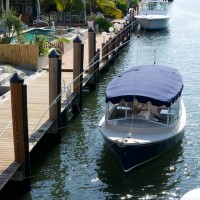
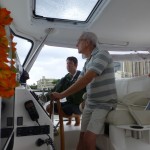
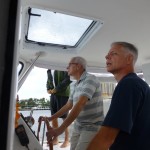
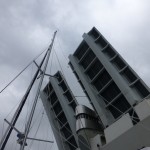
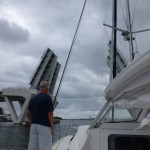

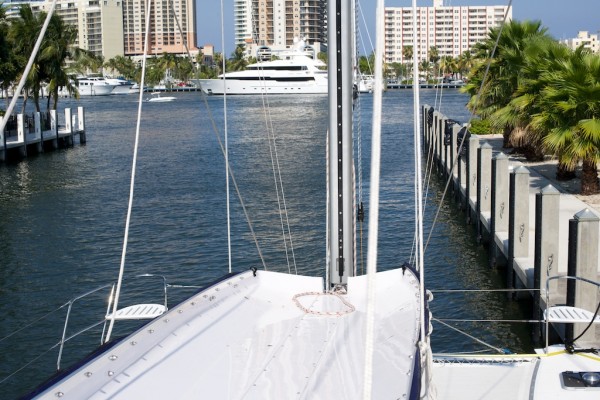
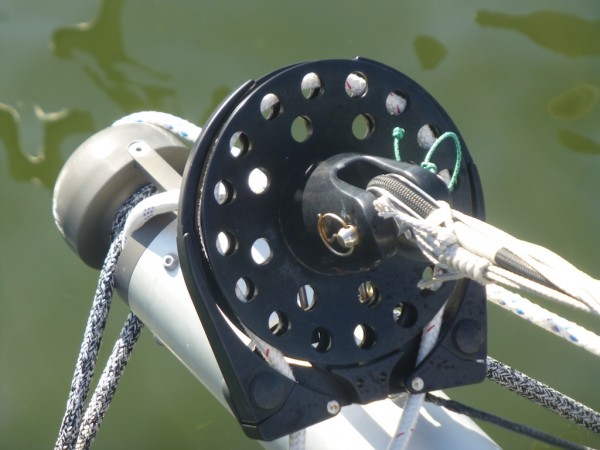
4 Responses to A day sail turns into more